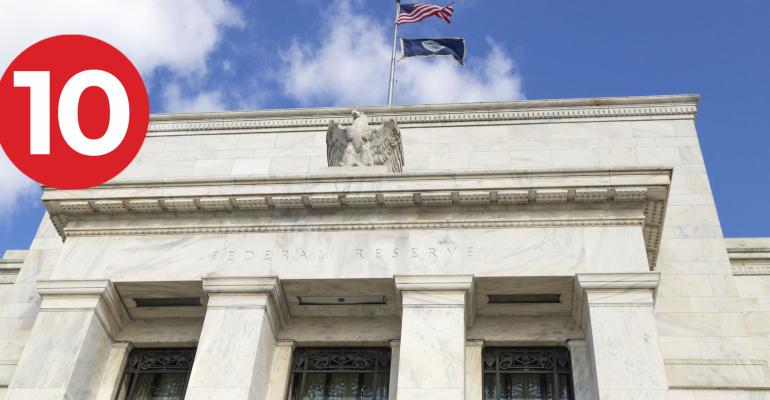- Fed Continues to Worry About CRE Lending “The Federal Reserve’s Board of Governors have made it clear that while they think the ‘banking sector remains sound overall,’ there are problems, according to the November 2023 Supervision and Regulation Report. One of the troublesome spots they called out was bank lending to commercial real estate. ‘The banking system remains sound overall. Banking organizations continue to report capital and liquidity levels above regulatory minimums,’ they wrote.” (GlobeSt.com)
- Is CRE Lending Bottoming Out? “Although transaction activity remains modest, it appears that borrowing costs might have peaked, presaging renewed stability in the commercial real estate lending market, according to the third-quarter CBRE Lending Momentum Index, which was released Monday. CBRE Research states that the index declined by 3.0 percent since the second quarter, which in comparison to a fall of 47.9 percent year-over-year, suggests perhaps the worst is coming to an end.” (Commercial Property Executive)
- Are Alternative Investments Part of Your Economic Outlook? “Private equity is equity not on public exchanges the way corporation’s stocks are. As noted, alternative investments are more illiquid and liquidity varies greatly depending on the asset. With proper planning, an institution can invest in these assets without the issue of needing the money later. This is similar to the way financial advisors plan for clients whose needs can be met by way of alternative investment. According to Natixis, institutions relied on private markets for yields when rates were low. With equities looking down they look to these markets for capital appreciation.” (Forbes)
- As Rent Rises Cool, So Will Inflation “Inflation has been cooling, and a big part of why is that rent increases have as well. That is also why inflation is likely to keep going lower in the months ahead. Tuesday’s inflation report from the Labor Department showed that overall consumer prices were up 3.2% from a year earlier in October, while core prices, which exclude food and energy prices in an effort to better track inflation’s underlying trend, were up 4%. That core increase, while still obviously too high, was the smallest since September 2021, and a lot nicer than the 6.6% logged in September of last year.” (The Wall Street Journal)
- The Math Is Changing on Sunbelt SFR Investments “Investors have gone cold when it comes to purchasing homes in the previously hot Sunbelt markets, according to new data from Redfin. Rising mortgage rates, high home prices, and a lackluster rental market were the culprits.” (GlobeSt.com)
- The Low-Occupancy Strategy of Manufactured Housing Investing “Investing in real estate has always been regarded as a sound financial move, and while many investors gravitate towards high-occupancy properties, some are discovering the potential hidden in low-occupancy manufactured housing communities. Common reasons for low occupancy include mismanagement, lack of maintenance, outdated facilities, destruction from storm damage, and possibly even a poor reputation. Low-occupancy communities can be seen as distressed assets, but for investors with vision, they represent a chance to create substantial value.” (Colliers)
- Net Lease Cap Rates Up for the Sixth Consecutive Quarter “One of the frustrations in any form of technology is closed systems. It happens frequently — take mobile computing. What works on Android is typically incapable of being used on iOS, except for some obvious examples like JPG files or separate versions of the same basic app. When it comes to corporate needs, this gets complex, and building physical access control has been a major example.” (GlobeSt.com)
- Real Estate Investor Faces SEC Inquiry on WeWork Offer “A real estate investor facing scrutiny from lenders and investors is now the subject of a government inquiry into an offer to buy shares in WeWork Inc. The US Securities and Exchange Commission has sent inquiries to Jonathan Larmore, the founder of Arciterra Cos., about a Nov. 3 press release in which an entity called Cole Capital Funds said it was seeking to buy shares in the coworking company at a significant premium, according to a person familiar with the matter who asked not to be named.” (Bloomberg)
- MetaProp’s Latest Accelerator Program Comes with a Twist “Making New York City the global capital of proptech while supporting its real estate industry is a founding tenet of Manhattan-based early-stage venture capital firm MetaProp. Now, the VC firm is tying that goal to the latest iteration of its accelerator program for proptech startups. MetaProp officially announced Tuesday that it is accepting applications for its 2024 MetaProp Accelerator @ Columbia University, a program it conducts annually in association with the Ivy League school in Manhattan.” (Commercial Observer)
- Why Your Office Space Continues to Shrink “In the decade before the pandemic, the amount of office space per worker in the US shrank steadily — a trend given the charming name “densification.” Saving money was one driver, as was a belief among some employers that denser layouts encouraged interaction and innovation. But the best predictor of densification was ‘market-level job growth and the availability of space (or lack thereof),’ commercial real estate brokerage Cushman & Wakefield concluded in a 2018 analysis of the phenomenon.” (Bloomberg)
0 comments
Hide comments





